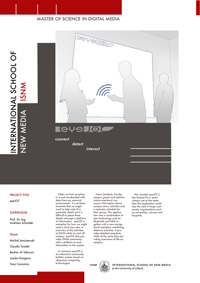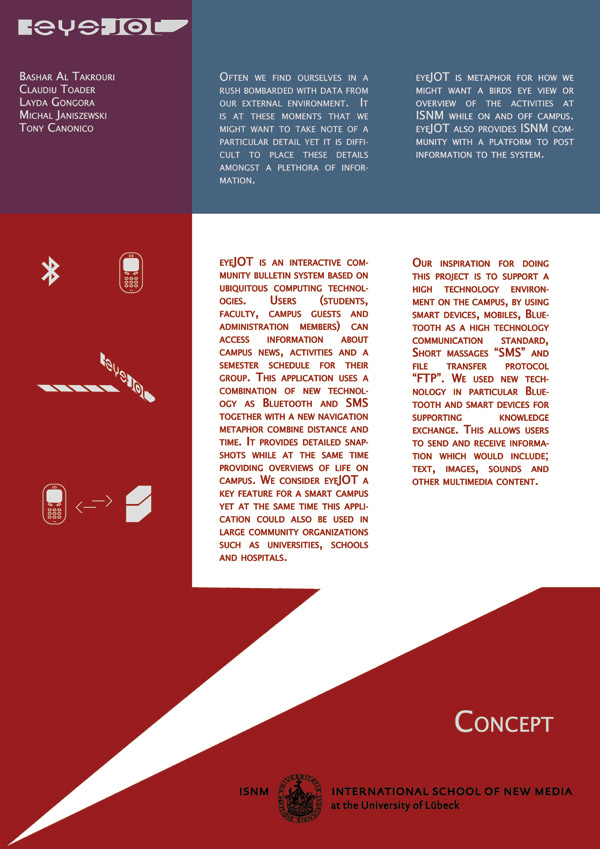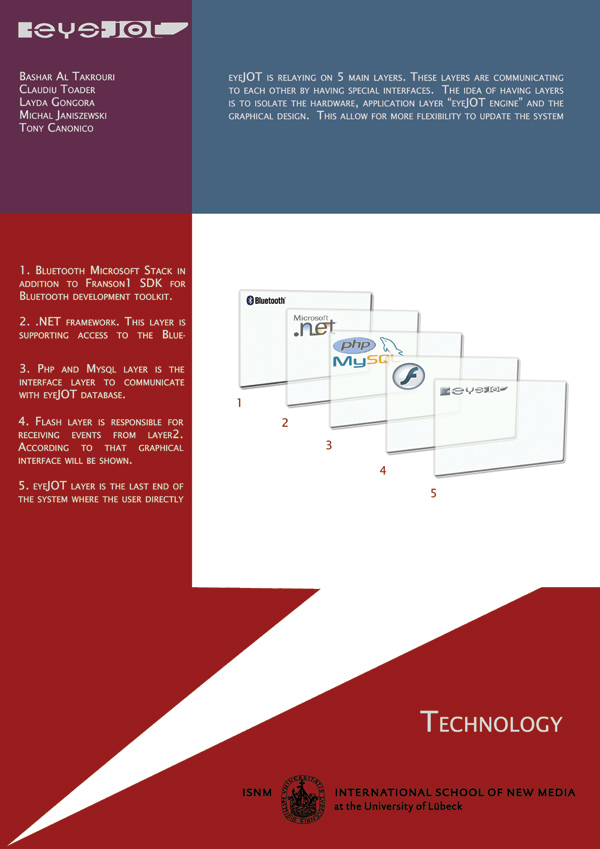+++++++++++++++++++++++++++++++++++
This List of Projects maintained till 2015
+++++++++++++++++++++++++++++++++++
Sound of the City: Crowd-based Noise Monitoring
Sound of the City is an authoring, navigation, and visualization service for publicly available geo-tagged noises (for noise avoidance) and sounds (soundscape) feeds in the city of Luebeck. At the core of this service is a community based approach to use user's mobile phones to act as live geo-noise and geo-sound sensors. Users can enjoy using the application to observe noise level and sounds simply navigating through a sound map for the city to get an immediate noise level and sounds visualizations. This project was initially developed by students at the "Mobile Multimedia Course" at the University of Luebeck lectured by Prof. Andreas Schrader.
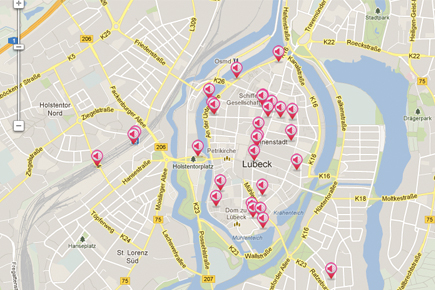
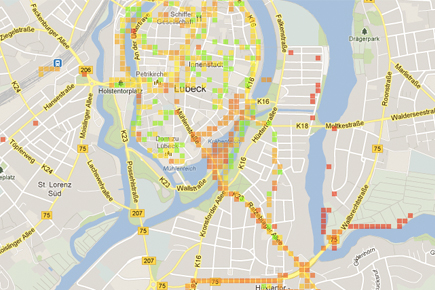
Date: 01.02.2012 - 01.06.2012.
Work at: Ambient Computing Group, Luebeck University, Germany
Role: Team instructor, Android and Javascript development
Website: Sound Of The City
Spin&Swing: Spatial Interaction with Orientation Aware Devices
Spin&Swing is a spatial interaction technique that leverages user’s orientation as an active input to interact with mobile applications. With Spin&Swing, a user can trigger a variety of mobile operations by orienting her spatially-aware mobile device with in the circle around her. In the current prototype this 360° circular orientation is mapped into temporal dimensions enabling users to browse and visualize historical interaction with an application in context. The demo showcases a prototype application where we have utilized this technique using an Apple iPhone to visualize and browse the historical information recorded by a digital memory augmented shoe in a personal travel log application.


Date: 30.02.2010 - 20.05.2010.
Work at: Lancaster University, UK
Role: Interface design, iPhone development
Mainkofen project - Peripheral Healthcare Documentation
The Mainkofen project investigates to what degree automatic activity recognition can support the use of hand held mobile devices for nursing documentation. The core idea is that by reducing the documentation to confirming a list of automatically recognized activities the documentation process can be done during periods of ”forced low intensity activity” such as walking from patient to patient or waiting for the coffee machine. The project also studies the impact of activity recognition errors. This project was performed at Mainkofen Hospital in Germany.

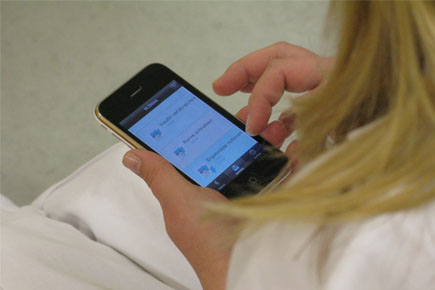
Date: 15.02.2010 - 26.03.2010.
Work at: Passau University, Germany
Role: Interface design, iPhone development
HolstenTour: Mobile Museum Tourguide
In this research, performed as a Master Thesis at the ISNM (Bashar Altakrouri), a novel infrastructure, called Medient Infrastructure is based on Web Services, Service Oriented Architecture and an Event-driven approach. The 'HolstenTour' project was realized as a class project of 'Ubiquitous Computing' in 2007. The project was sponsored by the ULR - Unabhängige Landesanstalt für Rundfunk und Neue Medien, the regional office for radio broadcasting and new media of Schleswig-Holstein, Germany and produced in cooperation with the Cultural Foundation of Luebeck, Germany. The HolstenTour prototypes an interactive ubiquitous solution for the Holstentor museum in Luebeck. Main concept is to provide personalized context-aware mobile tours to museum visitors using their own mobile devices. Technically, the project is build on the Medient Infrastructure developed by Bashar Altakrouri in his master thesis.

Visitors are welcomed at the entrance via a touchscreen interface, which support exploring connection between places in the city of Luebeck and the exhibition in the Holstentor museum. The personalized tour can then be 'downloaded' to the visitors mobile phone, which is identified throughout the museum using Bluetooth sensors. Respective content is pushed to the mobile phone of the visitor while browsing the museum space using reverse AJAX mechanisms and mobile browser displays. The project supports text, images, audio and video material.
HolstenTour from ISNM School of New Media on Vimeo.
Date:01.01.2007 - 01.12.2007.
Work with: International school of new Media, Germany.
Team:
Prof. Dr. Andreas Schrader, Bashar Al Takrouri, Veronica Hulea, Karen Detken, Steve Stein, Mari-Klara Oja, Katja Novitskova, Carlos Martinez, Varvara Guljajeva, Luo Zhu, Georges Belinga, Loreto Jacque, Xiaojing Fan, Yunpei Wu, Hong Chun, Lihua Song
Role: Team member, systems design, mobile and web services programmer
More: Holstentour website
Pamir Seafair Memorial Pamir Seafair Memorial
Interactive Seafair Memorial.
Date:11.2006 - 09.2007.
Work with: International school of new Media, Germany and Kirchengemeinde St. Jacobi zu Lübeck.
Sponsor: Lions Club Lübeck.
Role: Team member, interactive systems design, c# and actionscript porgrammer
More: ISNM website
Pictory: A table-top game based on Search Engine retrieved images
“Pictory” is a socially interactive, learning promoting, and thinking/imagination enhancing game that brings together human players, objects, physical spaces, newly developed system architectures, and existing search engines. It is a two-team, table-top game, in which the aim of each team is to get as many castles as possible both by keeping their own castles intact and by conquering opponent’s castles. The graphic interface consists of a beamer projection on a table surface, where four castles per team are displayed. The teams take turns in defending and attacking. The defense of a castle is realized by the defending team setting a keyword, which is then automatically inserted by the system in an image search engine. The retrieved images are displayed for the attacking team to see. If the concealed keyword is guessed within a specific time and a fixed number of guesses, the castle is considered as conquered; if not, the defending team retains the castle.
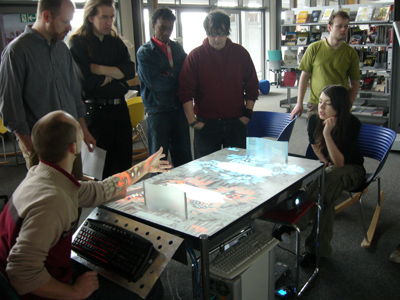
Picture 1 : Pictory Demonstration March 7,2007
Then, the teams exchange their roles and the same rules apply. When each of the teams has defended and attacked once, a round is completed. The game ends after four rounds. The team that has more castles or, in the case of equal numbers, the team that has used less time and has given less wrong guesses, wins. The main idea of the system architecture of “Pictory”, realized in C#, is to separate the visual layer from the logical/control layer, thus reducing the level of dependency between the two layers and increasing the game flexibility.

Picture 2 : Pictory Demonstration March 7,2007
The architecture functionalities are divided into two engines - Graphical engine and Game Logic and Control engine. The latter is responsible for the control of the login and for generating a set of events. Those events are sent to the Graphical engine as updates about changes in the game setup and states. In addition, the XML description of the game is updated and sent to the Game engine in order to modify the visualization according to the current game state.
Date:15.12.2006 - 30.02.2007.
Work with: Game design class - International school of new Media, Germany.
Role: Team member, systems design, c# and actionscript porgrammer
More: Pictory website
Campus Memories: Learning with Contextualised Blogging
The projects is a joint effort of The Internal School of New Media and the Open University of Netherlands to develop a new system based on Web Service architecture and mobile technology to combine the strengths of both mobile and context aware systems and apply them to educational systems can lead to contextualised learning support. The developed system is an extension of current systems for blogging we call contextualised blogging. The conceptual model and architecture allows users to create and manage blogs from a mobile device and combine them with identification tags and therefore leave “blog traces” in a physical environment.

So far, the research group was able to develop a general framework for the contextualized blogging which includes the mobile client subsystem and the content service. A planed evaluation for the system will take place during January 2007 at the Educational Technology Expertise Centre (OTEC) in the Netherlands. The evaluation system called “Campus Memories: Learning with Contextualised Blogging”.
Project team
Bashar Al Takrouri
Tim de Jong
Marcus Specht
Date: 01.10.2006 - 01.12.2006.
Work with: Open University of the Netherlands, The Netherlands.
Role: Team member, systems design, Java webservice (JAX-RPC) developer and mobile porgrammer based on JAVA MIDlet.
More: Campus Memories Paper
eyeJOT
eyeJOT is metaphor for how we might want a birds eye view or overview of the activities on and off the university campus, it is an interactive community bulletin system based on ubiquitous computing technologies.

Picture 1 : eyeJOT Demonstration at Open house July 7,2006
at International School of New Media, Luebeck, Germany.
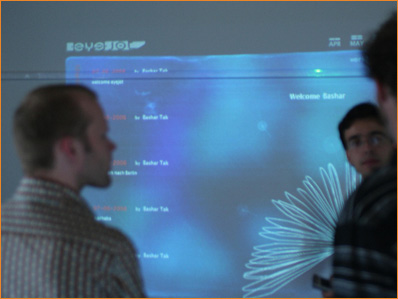
at International School of New Media, Luebeck, Germany.
Users (students, faculty, campus guests and administration members) can access information about campus news, activities and a semester schedule. eyeJOT uses a combination of new technology as Bluetooth and SMS together with a new navigation metaphor combine distance and time.
Picture 3 : eyeJOT Posters at Open house July 7,2006
at International School of New Media, Luebeck, Germany.
Work with: International school of new Media, Germany.
Position: Team leader ,C# and flash8 programmer. More: eyeJOT website
Competence Transfer
Create the research study “LEVELS”. Methods of cluster theory and network analysis is sought to be linked with the transfer of competences between entrepreneurs of various businesses and firms, all working in a so-called “entrepreneurial park”.

LEVELS combines methods from cluster theory and network analysis of the “New Growth Theory” (NGT) and evaluates the measurable degree of competence transfer taking place. The study takes “media docks” as the local cluster and sets it into comparison with “international champions”. This benchmarking derives key indicators for competence transfer in industrial clusters and provides insights into its managerial denominators.
Project Goal
Cluster reduces transaction cost and raise communication and flexibility
Background:
_ Cluster formation is described as a self-organizing process.
_ Major control variable of all clusters is “knowledge density”.
_ Social networks enable “knowledge exchange”.
_ Our assumption:
_ “Competency” not “knowledge” is the appropriate basis for analysis.
_ Project goal: A method comparison of cluster and network analysis with competency transfer
date: 15.03.2006 - 01.08.2006.
Work with: International school of new Media, Germany.
Role: Spss, Visualbasic and research.
More: Levels website
Online Quiz Tool
An online Quiz tool, for the International Conference on Technology Supported Learning and Training.
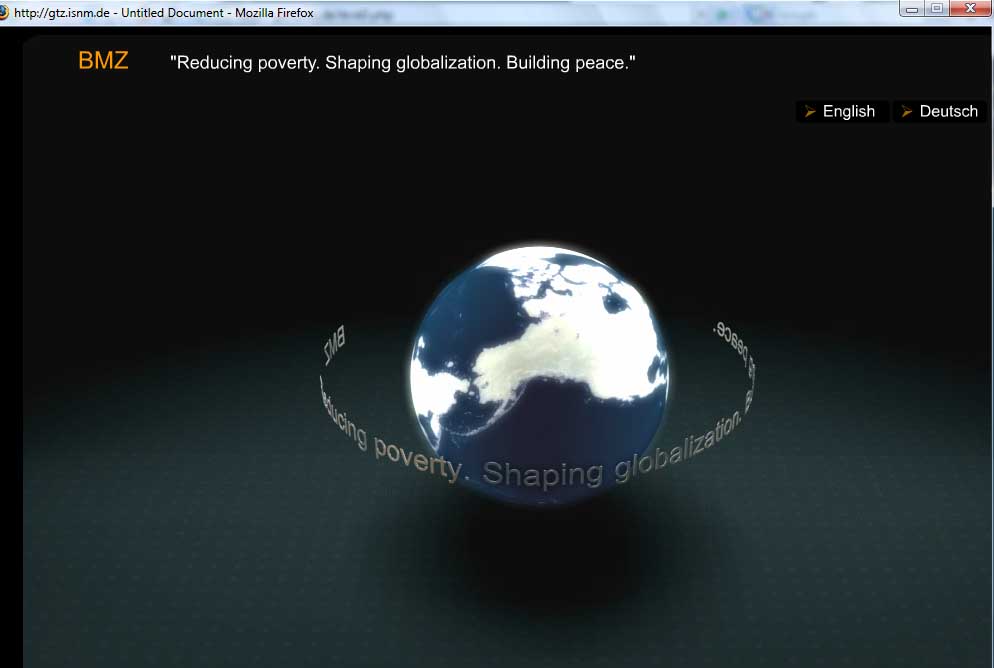
date: 25.02.2006 - 20.04.2006.
Work with: GTZ and International school of new Media, Germany.
Role: Web programming using JAVA and MYSQL database..
More: Quiz website
PORTNET
Visualizing transport/supply-chains in the Baltic Sea Region
The ISNM International School of New Media has been commissioned by the Business Development Group Lubeck to research methodologies to build a system able to visualize goods flows in the Baltic Sea Region on different levels: countries, regions, cities and down to single companies.
We have been able to proof the feasibility of such a system and have built a prototype to demonstrate the research results.
The system uses as input a database of companies and their products from external media or online sources. Based on a selection of product types, a web mining module collects and semantically analyses online data and builds a database of relations between companies, based on an exchange of goods. A second module collects publicly available cargo tracking data from port authorities and organisations and builds a database of transport chains.
A visualization module combines the business relations, goods flows and geographic positions into maps. These maps can be used to investigate relations between companies in different regions and the actual routes of goods, revealing for example gaps in the logistic coverage of certain ports, thus providing support for decisions on their future development.
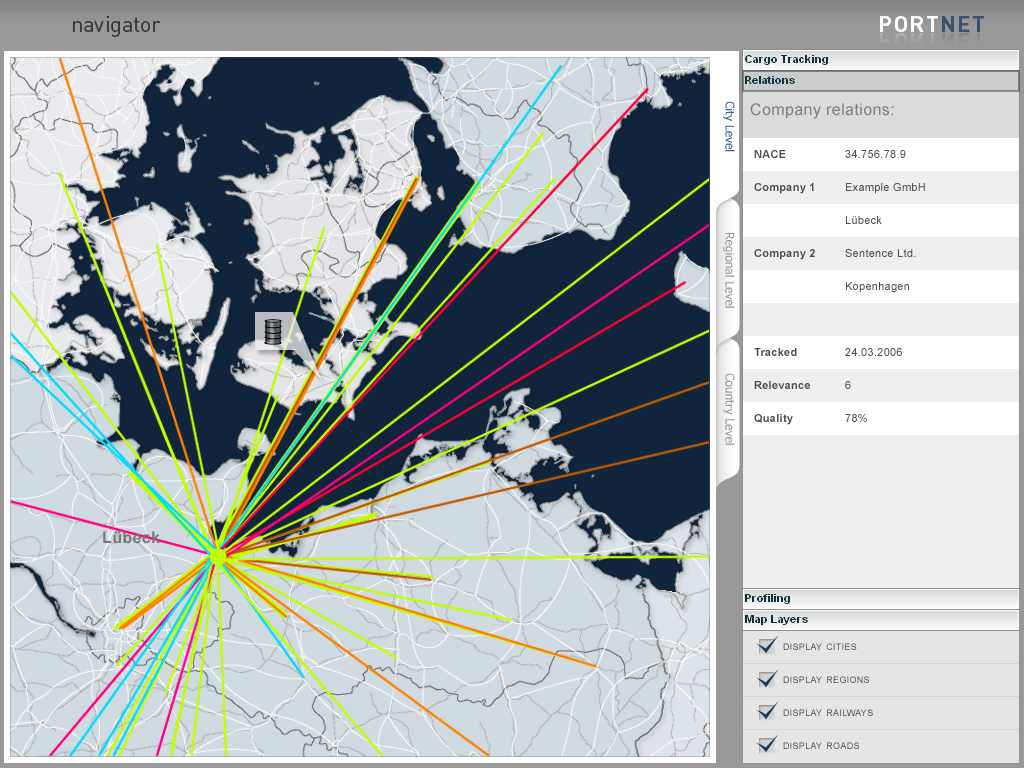
The research has been realized at the ISNM by an interdisciplinary team of developers, computer scientists, graphic and computational designers, a combination that led to a methodologically strong, conceptually novel and visually rich solution.
Project team
Ulrich Schmidts (schmidts AT isnm.de)
Wendy Ann Mansilla (w.mansilla AT isnm.de)
Bashar Al Takrouri (bashar_tak AT isnm.de)
Michal Janiszewski (m.janiszewski AT isnm.de)
date: 01.10.2005 - 31.03.2006.
Work with: International school of new Media, Germany.
Role: Web programming using JAVA and MYSQL database.
More: ISNM research blog


